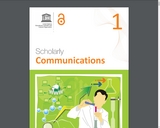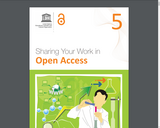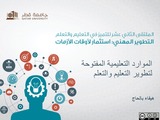![The Other Fifty Weeks: An Open Education Podcast [Episode 9]](https://img.oercommons.org/160x134/oercommons/media/courseware/lesson/image/16-344-The-Other-Fifty-Weeks-Podbean-v21_7rrxNGi.jpg)
The ninth episode of "The Other Fifty Weeks: An Open Education Podcast", discussing the affordances and freedoms of openness with Cable Green.
- Subject:
- Higher Education
- Material Type:
- Case Study
- Author:
- Adrian Stagg
- Date Added:
- 05/09/2022
![The Other Fifty Weeks: An Open Education Podcast [Episode 9]](https://img.oercommons.org/160x134/oercommons/media/courseware/lesson/image/16-344-The-Other-Fifty-Weeks-Podbean-v21_7rrxNGi.jpg)
The ninth episode of "The Other Fifty Weeks: An Open Education Podcast", discussing the affordances and freedoms of openness with Cable Green.

Researchers, scholars and scientists main business is scholarly communication. We communicate about our work to others, as we push the boundaries of what we know and the society knows. We question established notions and truths about science. We share our findings with others, and in a way that is popularly known as scholarly communication which emerged with the publication of first journal in 1665. However, the term gained popularity only in the 1970s, as access to peer reviewed and scholarly communication became difficult. This module has four units covering introduction to scholarly communication, peer reviewed journals, electronica journals and databases and the Serials Crisis. At the end of this module, the learner is expected to be able to:
- Explain philosophy, mission, and objectives of scholarly communication
- Describe the process of scholarly communication
- Identify different channels of scholarly communication
- Discuss the dysfunctioning of the scholarly communication
In Unit 1, Introduction to scholarly communication, we have discussed different aspects of scholarly communication – particularly its genesis, importance and ethics of academic publishing, and different communication channels available in academic publishing. Some of these channels are commonly described as primary sources as they provide first-hand testimony or direct evidence concerning a topic under investigation. Historically, scientific journals were initiated by learned societies and other scholarly communities for reporting results of concluded research works or scientific discoveries. Now many forprofit publishers have started publishing research journals.
Unit 2, Communicating with Peer Review Journals, covers two important academic publishing channels, namely peer reviewed journals, conferences and their proceedings. This Unit also highlights different methods and procedures of peer reviewing for publishing primary literature emanated from research studies. The peer reviewing is essential for validating quality of research findings conveyed by researchers, which are subject to fulfilment of ethical standards and appropriate research design, sampling and other methodological issues.
In Unit 3, Electronic journals and databases, we have discussed the emergence of electronic journals in academic and research environment due to wide proliferation of information and communication technologies (ICT) in research communications and academic publishing. Scientific communities and scientific communications from the global South are getting substantive attentions through adaptation of electronic journals and electronic academic databases in the process of research communications.
In Unit 4, the Serials Crisis, we discuss the cost of peer reviewed publications and the problems faced by researchers in developing countries. The focus of this unit is on highlighting the problems and discusses possible solutions including the emergence of open access as one of the solutions. Open access journal publishing helps in mitigating some of the problems associated with serials crisis.
This is Module One of the UNESCO's Open Access Curriculum for Researchers.
Full-Text is available at http://unesdoc.unesco.org/images/0023/002319/231938e.pdf

This is the last Module of the course on Open Access for researchers. So far you have studied about Open Access, its history, advantages, initiatives, copyrights and licensing, evaluation matrix for research – all in the context of scholarly communication. In this Module with just two units, we would like to help you share your work in Open Access though repositories and journals. At the end of this module, you are expected to be able to:
- Understand the publication process involved in dissemination of scholarly works;
- Choose appropriate Open Access journals and repositories for sharing research results;
- Use social media to promote personal research work and build reputation.
In Unit 1, we discuss the research publication process at five stages – planning stage, preparing stage, pre-publication stage, publication stage and postpublication stage. We emphasize the importance of social media in sharing and making your work visible to the target groups.
In Unit 2, we focus on sharing your research through OA repositories and Journals. First we discussed the different types of repositories to select and highlighted the steps that you may consider including deposit in your own institutional repositories or in global open repositories. We then discuss the sources of finding and deciding on OA journals. This unit also provides guidance on choosing the right OA journals, as the quality of OA journals is often questioned.
This is Module Five of the UNESCO's Open Access Curriculum for Researchers.
Full-Text is available at http://unesdoc.unesco.org/images/0023/002322/232211E.pdf

مع تطور التكنولوجيا و الويب، أصبح من السهل لاي متصفح إيجاد المعلومات و المراجع و أصبح البعض يستعملها دون الاهتمام بالملكية الفكرية و دون التأكد من صحة و نجاعة هذه المعلومات. من أجل حماية الكاتب واتاحة فرص أكبر للمستعمل والتشجيع على اصدار محتوى تعليمي ذي جودة، انتشرت حركة الموارد التعليمية المفتوحة في العالم.
- فماهي هذه الموارد؟ وماهي تراخيص الملكية الفكرية التي تحكم استخدامها؟
- كيف يمكن للأستاذ ان يجدها بسهولة على الوب؟
- كيف تساعده على الابتكار في ظل منهج التعليم المتمركز حول المتعلم؟
كل هذه الأسئلة يطرحها هذا العرض الذي قدم في الملتقى الثاني عشر للتميز لمركز التميز في التعليم و التعلم بجامعة قطر.